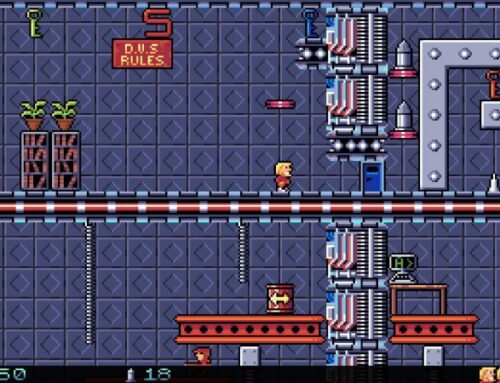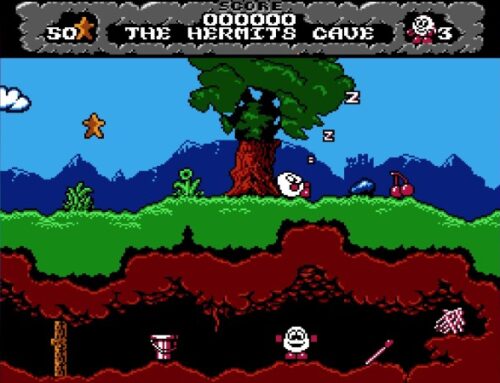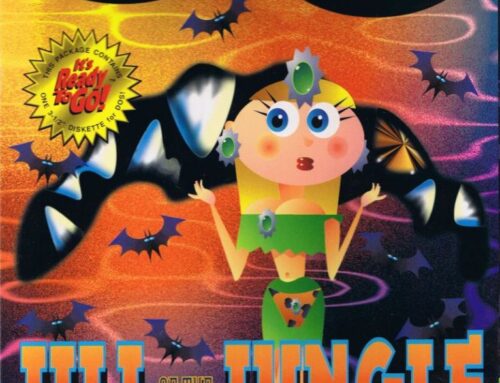A little while back, the once-renowned simulation-centric brand MicroProse hauled itself out of the grave and started working on some new games — some of which actually look quite promising. Now, it seems, they’re collaborating with Atari as a publisher to bring back some of their classic titles from the early days of gaming, including genre-defining flight sim F-15 Strike Eagle, aerial combat strategy game The Ancient Art of War in the Skies, civilian flight sim Solo Flight, military combat sim Harrier Jump Jet and lightweight “what if?” dogfighting game Dogfight: 80 Years of Aerial Warfare.
These rereleases come after the partnership relaunched several Sid “Civilization” Meier strategy classics in November of 2021, including Decision in the Desert, Conflict in Vietnam and Crusade in Europe — all of which were some of the earliest examples of real-time strategy games before the genre became a bit more well-known and refined.
F-15 Strike Eagle and The Ancient Art of War in the Skies are available today (January 20, 2022), while Solo Flight, Harrier Jump Jet and Dogfight are set to launch in the week beginning January 24, 2022. So let’s take a look at each of these — and why you might want to revisit each of them.
F-15 Strike Eagle

F-15 Strike Eagle pretty much invented the modern military flight sim, which became popularised (primarily via MicroProse) throughout the ’80s and ’90s, but which declined to almost nothing after the turn of the century. By modern standards, it’s extremely simplistic and rather arcadey, but back when it originally released in 1984 it was revolutionary.
F-15 Strike Eagle offers a selection of different scenarios, each of which provide an open map you can fly around freely, fuel permitting. On each map are a series of targets, including surface-to-air missile (SAM) sites, airstrips which launch enemy fighters, and a primary target to destroy.
Your aim in each mission is to score as many points as possible by bombing targets, shooting down enemy aircraft, destroying your primary target and then, preferably, making it back to base in one piece — though you can also eject if things aren’t going well or you don’t think you’re going to make it. This is risky, though; you have a chance of being captured by the enemy if you eject, and if that happens your game is over just as if you’d crashed.
F-15 Strike Eagle allows you to battle aerial threats with both cannons and missiles as well as using chaff, flare and electronic countermeasures (ECM) to keep yourself safe. Bombing missions are handled with a single type of bomb.
F-15 Strike Eagle still plays surprisingly well today, although its almost total lack of graphical detail and chugging frame rate may put some modern gamers off. The trouble with the new Steam version of it is that they picked the absolute worst version to rerelease: the CGA PC version, which features an absolutely rancid colour palette and particularly ugly visual presentation in general.
It would have been much nicer to see a port of the Atari 8-bit version — this is the platform the game actually originated on, after all — or, in a pinch, the NES version. Basically anything other than the version they picked — though I suspect they used the CGA PC version as it was simplest to get up and running in DOSBOX, did not require third-party ROM files (as an emulated Atari 8-bit version would) or licensing of an emulator (as the NES version would). That doesn’t quite explain why they didn’t use the revised 1986 EGA version, though…
Oh well. It’s still a good game; if you can get past the vomit-inducing colour palette, you can enjoy F-15 Strike Eagle right now on Steam.
The Ancient Art of War in the Skies

This rerelease makes a lot more sense, and will likely be much more palatable to a modern audience thanks to its 256-colour VGA graphics. It is, however, an unusual and interesting game that takes a bit of time to get to grips with, since rather than being a typical MicroProse flight sim it’s actually an action-strategy game, encompassing top-down strategic play as you plan out missions for your squadrons and then take direct control of them in action sequences representing dogfights, bombing runs and squadron-on-squadron battles.
The game is based on the writings of Sun Tzu, who wrote his legendary publication The Art of War in the 5th Century BC. There weren’t a whole lot of aeroplanes around back then, though, so it’s fair to say that a certain amount of creative interpretation has been taken — particularly as it’s possible to actually choose Sun Tzu as one of your opponents in the game’s missions.
The game includes 20 historically accurate missions and 34 more fictional campaigns, plus a full campaign editor that allows you to create your own scenarios down to the very last detail, rule and narrative component.
It’s a tricky game that will likely take a while to “click” with many people — but once it does, there’s a thoroughly compelling wargame to enjoy here. Nab a copy for yourself on Steam.
Solo Flight

Another early work from Sid Meier for MicroProse, Solo Flight is a third-person civilian flight simulator, once again originally written for Atari 8-bit and later ported to other platforms. The game can be played in two main modes: a freeform flying simulation where you can explore the world and land at any of the 21 airports in the game, and a Mail Pilot game where you have to deliver mail to five of these airports — occasionally dealing with mechanical and instrument failures.
The game allows you to play by both visual flight rules and the instrument flight rules that come into play during periods of limited visibility, though the game drew some criticism for the latter aspect not being as authentic as it could be — Sublogic’s Flight Simulator II (the game that would later become Microsoft Flight Simulator) put it to shame in this regard, even back in 1983. That said, the game was still praised for its realism and the quality of its documentation — though some reviewers found actual navigation between the different airports to be challenging.
The Steam page for this one isn’t live at the time of writing but if F-15 Strike Eagle is anything to go by, it’s likely we’ll be getting the PC version of this one running on DOSBOX too — which means more eye-assaulting CGA colour palettes to enjoy. Still, once again, if you can put up with that assault on your ocular nerves, Solo Flight is an interesting example of the early days of civilian flight simulation, and worth experiencing.
Solo Flight is set to launch on Steam in the week beginning January 24, 2022.
Harrier Jump Jet

If you can’t quite deal with the CGA visuals of F-15 Strike Eagle — they were ugly even back in the day, after all — then Harrier Jump Jet may be more interesting to you if you’re in the mood for a retro flight sim. This one originally came out from MicroProse in 1992 and features full 256-colour VGA polygonal graphics as well as an impressive amount of ground detail for a flight sim of the period.
The GR7 and AV-8B variations of the Harrier II were popular aircraft to simulate in the mid-to-late ’80s and early ’90s because they incorporated exciting new technology. Their vertical or short takeoff and landing (V/STOL) abilities made them unusual and distinctive compared to other jet fighters, and ideal to be explored through computer simulation. The games based on the Harrier vary in quality quite significantly over the years, but Harrier Jump Jet is one of the better ones.
1992 is very much when MicroProse was in its prime with regard to jet fighter simulations; it was around this time that the company completely jumped ship from the popular Atari ST and Commodore Amiga platforms that it had previously been supporting in favour of focusing exclusively on MS-DOS PCs. This allowed them to take full advantage of what had become, by this point, significantly and noticeably superior graphics and sound technology than the older platforms had to offer.
Through 256-colour VGA graphics, sound cards, faster processors and more affordable hard drives and RAM, MicroProse was able to realise its ambitions for these games better than ever before. And Harrier Jump Jet is a great example of that — though it did draw some criticism for its campaigns lacking depth compared to some other flight simulations on the market. Notably, Spectrum Holobyte’s Falcon 3.0 (published by MicroProse in Europe) had released the previous year, and had set the bar pretty high with its dynamic campaign; many other flight sims struggled to catch up for quite some time.
As a natural evolution of the formula established by F-15 Strike Eagle and its spiritual successors, though, Harrier Jump Jet is hard to beat, and is a prime example of MicroProse at its best. Watch out for it on Steam in the week beginning January 24, 2022.
Dogfight: 80 Years of Aerial Warfare

On paper, Dogfight sounds like an absolute dream flight sim: a game which allows you to fly any one of twelve different aircraft ranging from World War I’s Sopwith Camel up to the then-current F-16A Fighting Falcon and MiG-23S Flogger B, then pit them against any other of those twelve aircraft to see who comes out on top. Can a rickety old biplane take down a jet fighter? Are a modern aircraft’s fancy avionics any use when challenging an aircraft with no electronic components, held together with sticky tape and earnest prayers?
However, the reality was a little disappointing for some. The level of realism in the flight model was well below what people had come to expect from MicroProse, while the lack of coherent campaigns for the different time periods left some feeling like the game had limited lasting appeal. It wasn’t that developer Vektor Grafix was incapable of putting together a good flight sim, either; just the previous year they’d developed B-17 Flying Fortress for MicroProse, which was widely praised for its varied, interesting gameplay. It was likely more simply a case of the game’s ambitious concept being a little beyond what was possible to practically achieve at the time.
That said, if you’re just in the mood to hurl a variety of (very) different aircraft around the sky and blast some things to smithereens, Dogfight is a huge amount of fun, realism be damned. And as a 1993 title from MicroProse, it looks and sounds nice, too. Don’t pass this one up just because of the mediocre reviews back in the day; this is an enjoyable lightweight game that sometimes is just what the doctor ordered.
Dogfight: 80 Years of Aerial Warfare will be available on Steam in the week beginning January 24, 2022.




